How To Transcribe Chinese (Cantonese, Traditional)
Chinese (Cantonese, Traditional) is one of the most widely spoken languages in the world. It is used in countries such as Hong Kong, Macau, Singapore, Taiwan, mainland China, and other parts of Asia. According to the World Atlas, Chinese (Cantonese, Traditional) is the second most commonly spoken language in the world with over 1.1 billion speakers.
Transcription is the process of converting audio or video content into text. It is an important part of the speech recognition process and is useful for many applications, such as creating subtitles for a video, creating a transcript of a podcast, or for research purposes. Transcribing audio and video content in Chinese (Cantonese, Traditional) can be a difficult and time-consuming task, but it's essential for accurately understanding the content.
Why Transcribe Chinese (Cantonese, Traditional) Content?
Transcription can be extremely useful for researchers, marketers, and businesses. For researchers, it can provide a way to quickly analyze large amounts of audio and video content in Chinese (Cantonese, Traditional). For marketers, it can help to better understand customer feedback, as well as trends in customer conversations. For businesses, it can be used to better understand customer interactions, as well as to create transcripts for customer service and training.
How To Transcribe Chinese (Cantonese, Traditional) Content
When it comes to transcribing audio and video content in Chinese (Cantonese, Traditional), the best option is to use a speech recognition and natural language platform such as Speak AI. Speak AI's speech recognition platform is designed to accurately transcribe audio and video content in a variety of languages, including Chinese (Cantonese, Traditional). The platform is also easy to use and can be used to quickly generate transcripts of audio and video content, as well as to analyze the content for trends and customer feedback.
Benefits of Transcription With Speak AI
Speak AI's speech recognition and natural language platform can be used to quickly and accurately transcribe audio and video content in a variety of languages, including Chinese (Cantonese, Traditional). The platform can also be used to analyze the transcription for trends and customer feedback, as well as to create transcripts for customer service and training. With over 40,000 users using the platform, Speak AI is the perfect solution for researchers, marketers, and businesses looking to transcribe audio and video content in Chinese (Cantonese, Traditional).
Use Cases for Transcribing Chinese (Cantonese, Traditional) Content
Transcribing audio and video content in Chinese (Cantonese, Traditional) can be used for a variety of applications. For researchers, it can be used to quickly analyze large amounts of audio and video content. For marketers, it can be used to better understand customer conversations and feedback. For businesses, it can be used to create transcripts for customer service and training.
Conclusion
Transcribing audio and video content in Chinese (Cantonese, Traditional) can be a difficult and time-consuming task, but it is essential for accurately understanding the content. Speak AI's speech recognition and natural language platform is designed to accurately transcribe audio and video content in a variety of languages, including Chinese (Cantonese, Traditional). With over 40,000 users using the platform, Speak AI is the perfect solution for researchers, marketers, and businesses looking to transcribe audio and video content in Chinese (Cantonese, Traditional).
How To Transcribe Chinese (Cantonese, Traditional) Using Speak

Step 1: Create a Speak Account
To start your Chinese (Cantonese, Traditional) transcription, you first need to create a Speak account. No worries, this is super easy to do!
Our team is happy to give you a 7-day trial with 30 minutes of free Chinese (Cantonese, Traditional) audio and video transcription included.
To sign up for Speak and start your Chinese (Cantonese, Traditional) transcription, visit the Speak app register page here.
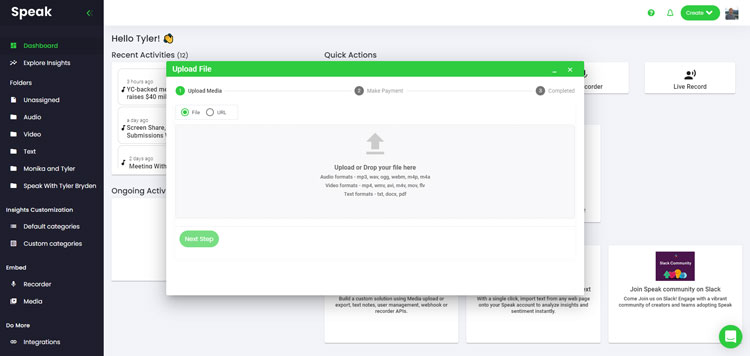
Step 2: Upload your Chinese (Cantonese, Traditional) file(s) for Transcription
We typically recommend MP4s for video or MP3s for audio.
However, we accept a range of audio and video file types. Once you upload your file all you have to do is select "Chinese (Cantonese, Traditional)" from the language dropdown menu to automatically transcribe in Chinese (Cantonese, Traditional).
You can upload your Chinese (Cantonese, Traditional) file for transcription in several ways using Speak:
Accepted Chinese (Cantonese, Traditional) Audio File Types
- Chinese (Cantonese, Traditional) MP3
- Chinese (Cantonese, Traditional) M4A
- Chinese (Cantonese, Traditional) WAV
- Chinese (Cantonese, Traditional) OGG
- Chinese (Cantonese, Traditional) WEBM
- Chinese (Cantonese, Traditional) M4P
Accepted Chinese (Cantonese, Traditional) Video File Types
- Chinese (Cantonese, Traditional) MP4
- Chinese (Cantonese, Traditional) M4V
- Chinese (Cantonese, Traditional) WMV
- Chinese (Cantonese, Traditional) AVI
- Chinese (Cantonese, Traditional) MOV
- Chinese (Cantonese, Traditional) FLV
Publicly Available Chinese (Cantonese, Traditional) URLs
You can also upload media to Speak through a publicly available URL.
As long as the file type extension is available at the end of the URL you will have no problem importing your recording for automatic transcription and analysis.
Chinese (Cantonese, Traditional) YouTube URLs
Speak is compatible with YouTube videos. All you have to do is copy the URL of the YouTube video (for example, https://www.youtube.com/watch?v=qKfcLcHeivc).
Speak will automatically find the file, calculate the length, and import the video.
Please make sure you use the full link and not the shortened YouTube snippet. Additionally, make sure you remove the channel name from the URL.
Speak Integrations
As mentioned, Speak also contains a range of integrations for Zoom, Zapier, Vimeo and more that will help you automatically transcribe your media.
This library of integrations continues to grow! Have a request? Feel encouraged to send us a message.
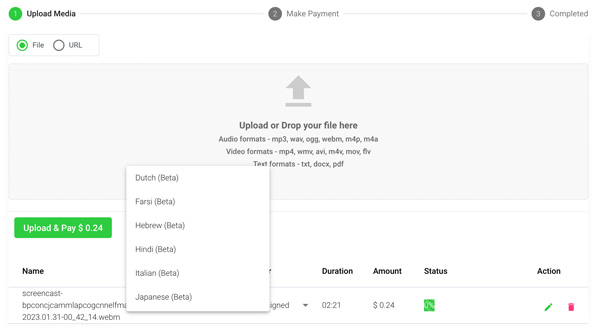
Step 3: Calculate and pay the total automatically
Once you have your Chinese (Cantonese, Traditional) audio or video file ready and load it into Speak, it will automatically calculate the total cost (you get 30 minutes free in the trial - take advantage of it!).
You can pay by subscribing to a personalized plan using our real-time calculator with included minutes.
You can also add a balance or pay for uploads without a plan using your credit card.
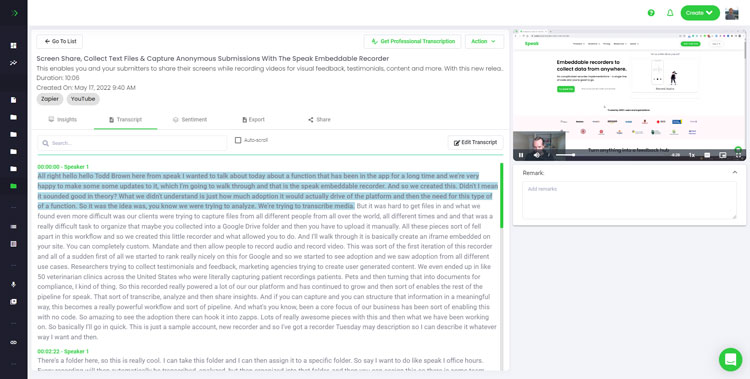
Step 4: Wait for Speak to transcribe your Chinese (Cantonese, Traditional) audio or Chinese (Cantonese, Traditional) video
Our automated transcription software will prepare your transcript in as little as a few minutes. Generally, Speak takes about half the audio or video length to produce the transcript and insights.
Once completed, you will get an email notification that your transcript is complete. That email will contain a link back to the file so you can access the interactive media player with the transcript, analysis, and export formats ready for you.
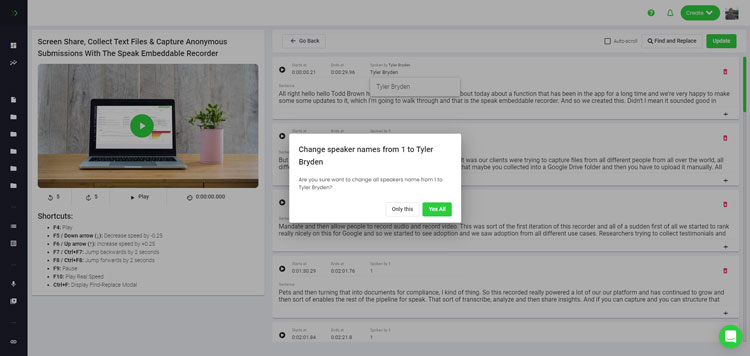
Step 5: View and edit your automated transcript
Want to tackle the transcript edits yourself? All good! Once you receive your automated transcript you have the option to edit your transcript at any time.
Easily update speaker names, find and replace, and get your automatic transcript up to full accuracy with our intuitive transcript editing system.
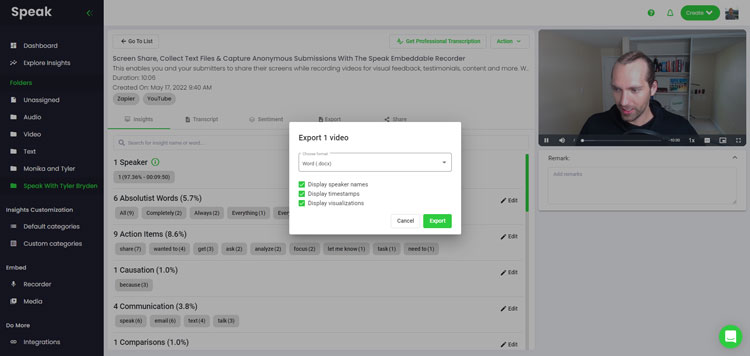
Step 6: Export your transcript and share interactive media players
You can export your transcript in PDF, Word, TXT, HTML and even more advanced formats like CSV or JSON depending on your plan.
A more effective way of sharing transcripts is through a shareable media library that includes the media file, AI insights and an interactive transcript.
There is so much more that you can do with Speak to enrich the value of your media and transcripts.
Never hesitate to send us a message on live chat - we are always here to help!
We talked about Chinese (Cantonese, Traditional) transcription here, but you may be interested in how to transcribe in other languages instantly and easily with Speak's intuitive transcription and natural language processing software. We’ve shared resources below on all the languages Speak can help you transcribe!
Join 40,000+ users finding radical efficiencies with their audio, video and text data to drive value.
How Much Does It Cost To Transcribe Chinese (Cantonese, Traditional)?
Speak offers highly competitive pricing for Chinese (Cantonese, Traditional) transcription compared to other transcription solutions. For a starting user, Speak offers automated Chinese (Cantonese, Traditional) transcription for only $0.06 USD per minute. That is only $3.6 USD per hour!
We also scale our pricing based on media volume and can offer even bigger discounts to large customers. So, if you have over 100 hours of Chinese (Cantonese, Traditional) transcription per month please contact us through live chat and we will set you up with a customized price per minute to make Chinese (Cantonese, Traditional) transcription even more affordable!
You can learn more about how to transcribe Chinese (Cantonese, Traditional) with Speak and the relevant pricing on the website pricing page and the in-app pricing page.
What Can You Transcribe In Chinese (Cantonese, Traditional)?
- Transcribe Chinese (Cantonese, Traditional) interviews
- Transcribe Chinese (Cantonese, Traditional) videos
- Transcribe Chinese (Cantonese, Traditional) audio
- Transcribe Chinese (Cantonese, Traditional) earnings calls
- Transcribe Chinese (Cantonese, Traditional) focus groups
- Transcribe Chinese (Cantonese, Traditional) meetings
- Transcribe Chinese (Cantonese, Traditional) phone calls
- Transcribe Chinese (Cantonese, Traditional) YouTube videos
- Transcribe Chinese (Cantonese, Traditional) Vimeo videos
- Transcribe Chinese (Cantonese, Traditional) Zoom recordings
- Transcribe Chinese (Cantonese, Traditional) Google Meet recordings
- Transcribe Microsoft Teams recordings
- Transcribe Chinese (Cantonese, Traditional) podcasts
And so much more!
How To Export Chinese (Cantonese, Traditional) Transcripts
With Speak, you can easily export Chinese (Cantonese, Traditional) transcriptions to many formats.
Below is a list of options for exporting your Chinese (Cantonese, Traditional) transcripts in Speak:
- Export Chinese (Cantonese, Traditional) transcripts to Word Docs
- Export Chinese (Cantonese, Traditional) transcripts to PDFs
- Export Chinese (Cantonese, Traditional) transcripts to CSVs
- Export Chinese (Cantonese, Traditional) transcripts to TXT files
- Export Chinese (Cantonese, Traditional) transcripts to HTML
- Export Chinese (Cantonese, Traditional) transcripts to SRTs
- Export Chinese (Cantonese, Traditional) transcripts to VTTs
- Export Chinese (Cantonese, Traditional) transcripts to JSON
How To Generate Chinese (Cantonese, Traditional) Captions
If you are looking to subtitle in Chinese (Cantonese, Traditional) or caption in Chinese (Cantonese, Traditional), Speak is a powerful solution. Speak’s automatic transcription software automatically generated Chinese (Cantonese, Traditional) transcripts with timestamps that enable Speak to quickly create SRT and VTT files necessary for Chinese (Cantonese, Traditional) captions and Chinese (Cantonese, Traditional) subtitles.
What Other Languages Can Speak Transcribe?
Speak already has users from over 90 countries and we continuously get requests to transcribe and analyze in different languages.
So, we continuously add more languages to Speak! Here are just some of the growing list of languages that Speak offers:
- Arabic (United Arab Emirates)
- Arabic Egypt
- Arabic (Iraq)
- Arabic (Israel)
- Arabic (Jordan)
- Arabic (Kuwait)
- Arabic (Lebanon)
- Arabic Modern Standard (Bahrain)
- Arabic (Oman)
- Arabic (Palestinian Authority)
- Arabic (Qatar)
- Arabic (Saudi Arabia)
- Arabic (Syrian Arab Republic)
- Arabic (U.A.E.)
- Armenian
- Bulgarian
- Catalan
- Chinese (Cantonese, Traditional)
- Chinese (Simplified)
- Croatian
- Czech
- Danish
- Dutch
- English (Australia)
- English (British)
- English (United Kingdom)
- English (United States)
- Estonian
- Farsi
- Finnish
- French
- French (Canada)
- German
- Greek
- Gujarati
- Hebrew
- Hindi
- Hungarian
- Icelandic
- Indonesian
- Irish
- Italian
- Japanese
- Kannada
- Korean
- Latvian
- Lithuanian
- Malay
- Malayalam
- Norwegian
- Persian
- Polish
- Portuguese
- Portuguese (Brazilian)
- Portuguese (Portugal)
- Romanian
- Russian
- Slovak
- Slovenian
- Spanish
- Spanish (Mexico)
- Swedish
- Tamil
- Telugu
- Thai
- Turkish
- Ukrainian
- Vietnamese
There are now many more added!
You can see the entire list of languages Speak supports through both the software and APIs.



